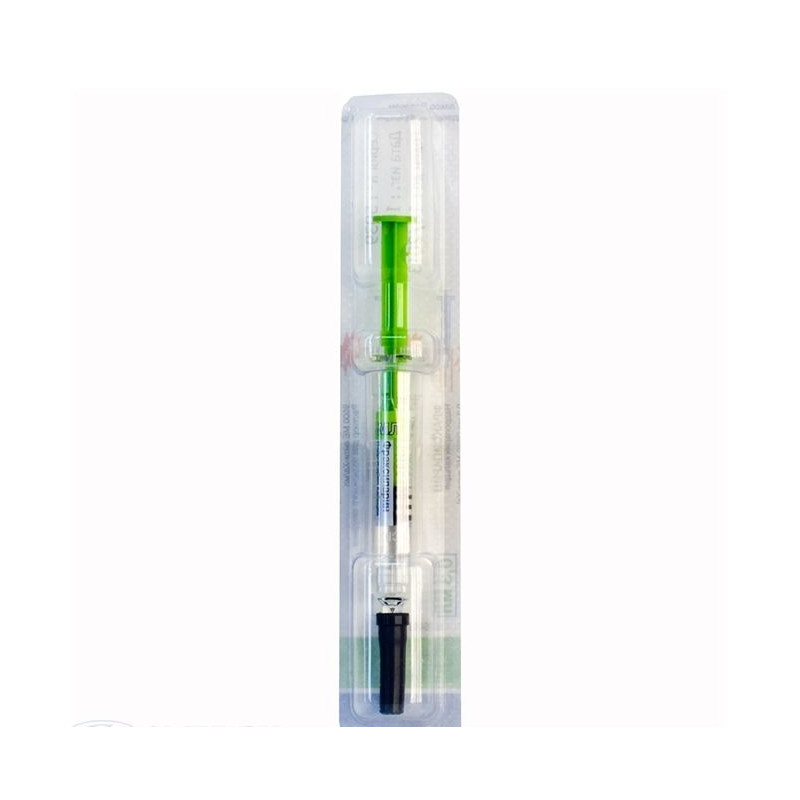



 All payments are encrypted via SSL
All payments are encrypted via SSL
 Full Refund if you haven't received your order
Full Refund if you haven't received your order
1 dose of the solution for s / c injection contains:
In a single dose syringe 0.3 ml solution. In the package 1 syringe.
Pharmacokinetic properties are determined based on changes in anti-Xa-factor plasma activity.
After s / c administration of Cmax in the blood plasma is reached after 3-5 hours, nadroparin is absorbed almost completely (about 88%). With i.v. administration, the maximum anti-Xa activity is achieved in less than 10 minutes, T1 / 2 is about 2 hours.
Metabolized mainly in the liver by desulfation and depolymerization.
After s / c administration, T1 / 2 is about 3.5 hours. However, anti-Xa activity persists for at least 18 hours after the injection of nadroparin at a dose of 1,900 anti-Xa ME.
In elderly patients, due to physiological impairment of renal function, elimination of nadroparin slows down. When using the drug for the purpose of prophylaxis, this category of patients does not need to change the dosing regimen in case of mild renal dysfunction.
In clinical studies on the pharmacokinetics of nadroparin with a / in the introduction of patients with renal insufficiency of varying severity was established correlation between clearance of nadroparin and creatinine clearance. When comparing the values obtained with those in healthy volunteers, it was found that AUC and T1 / 2 increase to 52-87%, and creatinine clearance to 47-64% of normal values. The study also showed large individual differences.
In patients with severe renal insufficiency, T1 / 2 of nadroparin increased by 6 hours during sc administration. The results of the study showed that a slight accumulation of nadroparin can be observed in patients with mild to moderate renal insufficiency (creatinine clearance ≥ 30 ml / min 60 ml / min.) Consequently, the dose of Fraxiparine should be reduced by 25% in patients receiving Fraxiparine to treat thromboembolism, unstable angina / myocardial infarction without a Q wave. Patients with severe renal insufficiency are contraindicated to treat these conditions.
In patients with mild to moderate renal insufficiency, when using Fraxiparine to prevent thromboembolism, the accumulation of nadroparin does not exceed that in patients with normal renal function,receiving Fraxiparine in therapeutic doses. When using Fraxiparine for the prevention of dose reduction in this category of patients is not required. In patients with severe renal failure who receive Fraxiparine in prophylactic doses, a dose reduction of 25% is necessary.
Low molecular weight Heparin is injected into the arterial line of the dialysis loop in sufficiently high doses in order to prevent blood from clotting in the dialysis loop. Pharmacokinetic parameters are not fundamentally changed, except in the case of overdose, when the passage of the drug into the systemic circulation can lead to an increase in anti-Xa factor activity, due to the final phase of renal failure.
Nadroparin calcium is a low molecular weight heparin (LMWH), obtained by depolymerization of standard heparin, is a glycosaminoglycan with an average molecular weight of 4300 daltons.
It exhibits a high ability to bind with plasma protein antithrombin III (AT III). This binding leads to accelerated inhibition of factor Xa, and this is due to the high antithrombotic potential of nadroparin.
Other mechanisms that provide the antithrombotic effect of nadroparin include activation of a tissue factor conversion inhibitor (TFPI), activation of fibrinolysis by direct release of a tissue plasminogen activator from endothelial cells, and modification of blood rheological properties (decrease in blood viscosity and increase in platelet and granulocyte membrane permeability).
Nadroparin calcium is characterized by higher anti-Xa factor activity compared to anti-IIa factor or antithrombotic activity and has both immediate and prolonged antithrombotic activity.
Compared with unfractionated heparin, nadroparin has less effect on platelet function and aggregation and less pronounced effect on primary hemostasis.
In prophylactic doses, nadroparin does not cause a pronounced decrease in APTT.
In the course of treatment during the period of maximum activity, it is possible to increase the APTT to a value 1.4 times higher than the standard. Such prolongation reflects the residual antithrombotic effect of nadroparin calcium.
Currently, there are only limited data on the penetration of nadroparin through the placental barrier in humans. Therefore, the use of Fraxiparine during pregnancy is not recommended, except in cases where the potential benefit to the mother exceeds the risk to the fetus.
Currently, there are only limited data on the allocation of nadroparin with breast milk. In this regard, the use of nadroparin during lactation (breastfeeding) is not recommended.
In experimental animal studies, no teratogenic effect of nadroparin calcium was detected.
Precautions should be prescribed Fraxiparine in situations associated with an increased risk of bleeding: with liver failure, with renal failure, with severe hypertension, with a history of peptic ulcers or other diseases with an increased risk of bleeding, with circulatory disorders in the choroid and retina, in the postoperative period after operations on the brain and spinal cord or in the eyes, in patients with a body weight less than 40 kg, with a duration of therapy exceeding rivers recommended (10 days), in case of non-compliance with the recommended treatment conditions (especially increasing the duration and dose for a course of use), when combined with drugs that increase the risk of bleeding.
Very often (more than 1/10), often (more than 1/100, less than 1/10), sometimes (more than 1/1000, less than 1/100), rarely (more than 1/10 000, less than 1/1000), very rarely (less than 1/10 000).
Very rarely, priapism, reversible hyperkalemia (associated with the ability of heparins to inhibit the secretion of aldosterone, especially in patients at risk).